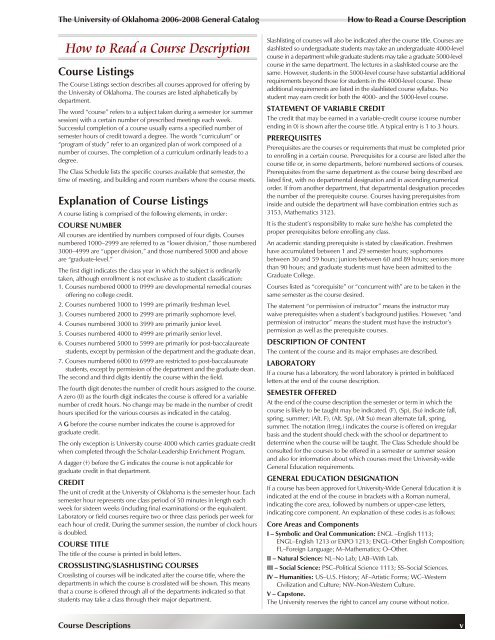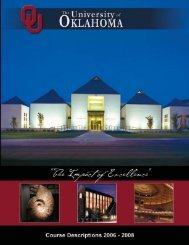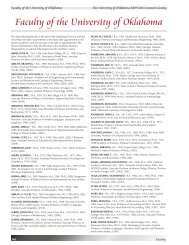2006-08 Course Descriptions - Catalog - University of Oklahoma
2006-08 Course Descriptions - Catalog - University of Oklahoma
2006-08 Course Descriptions - Catalog - University of Oklahoma
You also want an ePaper? Increase the reach of your titles
YUMPU automatically turns print PDFs into web optimized ePapers that Google loves.
The Uni ver sity <strong>of</strong> <strong>Oklahoma</strong> <strong>2006</strong>-20<strong>08</strong> Gen eral Cat a logHow to Read a <strong>Course</strong> DescriptionHow to Read a <strong>Course</strong> Description<strong>Course</strong> ListingsThe <strong>Course</strong> List ings sec tion de scribes all courses ap proved for <strong>of</strong> fer ing bythe Uni ver sity <strong>of</strong> <strong>Oklahoma</strong>. The courses are listed al pha bet i cally bydepartment.The word “course” refers to a subject taken during a semester (or summersession) with a certain number <strong>of</strong> prescribed meetings each week.Successful completion <strong>of</strong> a course usually earns a specified number <strong>of</strong>semester hours <strong>of</strong> credit toward a degree. The words “curriculum” or“program <strong>of</strong> study” refer to an organized plan <strong>of</strong> work composed <strong>of</strong> anumber <strong>of</strong> courses. The completion <strong>of</strong> a curriculum ordinarily leads to adegree.The Class Schedule lists the specific courses available that semester, thetime <strong>of</strong> meeting, and building and room numbers where the course meets.Explanation <strong>of</strong> <strong>Course</strong> ListingsA course listing is comprised <strong>of</strong> the following elements, in order:COURSE NUMBERAll courses are identified by numbers composed <strong>of</strong> four digits. <strong>Course</strong>snumbered 1000–2999 are referred to as “lower division,” those numbered3000–4999 are “upper division,” and those numbered 5000 and aboveare “graduate-level.”The first digit indicates the class year in which the subject is ordinarilytaken, although enrollment is not exclusive as to student classification:1. <strong>Course</strong>s num bered 0000 to 0999 are de vel op men tal re me dial courses<strong>of</strong>fering no college credit.2. <strong>Course</strong>s num bered 1000 to 1999 are pri mar ily fresh man level.3. <strong>Course</strong>s num bered 2000 to 2999 are pri mar ily soph o more level.4. <strong>Course</strong>s num bered 3000 to 3999 are pri mar ily ju nior level.5. <strong>Course</strong>s num bered 4000 to 4999 are pri mar ily se nior level.6. <strong>Course</strong>s num bered 5000 to 5999 are pri mar ily for post-bac ca lau re atestu dents, ex cept by per mis sion <strong>of</strong> the de part ment and the grad u ate dean.7. <strong>Course</strong>s num bered 6000 to 6999 are re stricted to post-bac ca lau re atestu dents, ex cept by per mis sion <strong>of</strong> the de part ment and the grad u ate dean.The second and third digits identify the course within the field.The fourth digit denotes the number <strong>of</strong> credit hours assigned to the course.A zero (0) as the fourth digit indicates the course is <strong>of</strong>fered for a variablenumber <strong>of</strong> credit hours. No change may be made in the number <strong>of</strong> credithours specified for the various courses as indicated in the catalog.A G before the course number indicates the course is approved forgraduate credit.The only exception is <strong>University</strong> course 4000 which carries graduate creditwhen completed through the Scholar-Leadership Enrichment Program.A dagger (†) before the G indicates the course is not applicable forgraduate credit in that department.CREDITThe unit <strong>of</strong> credit at the <strong>University</strong> <strong>of</strong> <strong>Oklahoma</strong> is the semester hour. Eachsemester hour represents one class period <strong>of</strong> 50 minutes in length eachweek for sixteen weeks (including final examinations) or the equivalent.Laboratory or field courses require two or three class periods per week foreach hour <strong>of</strong> credit. During the summer session, the number <strong>of</strong> clock hoursis doubled.COURSE TI TLEThe title <strong>of</strong> the course is printed in bold letters.CROSSLISTING/SLASHLISTING COURSESCrosslisting <strong>of</strong> courses will be indicated after the course title, where thedepartments in which the course is crosslisted will be shown. This meansthat a course is <strong>of</strong>fered through all <strong>of</strong> the departments indicated so thatstudents may take a class through their major department.Slashlisting <strong>of</strong> courses will also be in di cated af ter the course ti tle. <strong>Course</strong>s areslashlisted so undergraduate students may take an undergraduate 4000-levelcourse in a de part ment while grad u ate stu dents may take a grad u ate 5000-levelcourse in the same de part ment. The lec tures in a slashlisted course are thesame. How ever, stu dents in the 5000-level course have sub stan tial ad di tionalre quire ments be yond those for stu dents in the 4000-level course. Thesead di tional re quire ments are listed in the slashlisted course syl la bus. Nostu dent may earn credit for both the 4000- and the 5000-level course.STATE MENT OF VARI ABLE CREDITThe credit that may be earned in a vari able-credit course (course num berend ing in 0) is shown af ter the course ti tle. A typ i cal en try is 1 to 3 hours.PREREQUISITESPrerequisites are the courses or requirements that must be completed priorto enrolling in a certain course. Prerequisites for a course are listed after thecourse title or, in some departments, before numbered sections <strong>of</strong> courses.Prerequisites from the same department as the course being described arelisted first, with no departmental designation and in ascending numericalorder. If from another department, that departmental designation precedesthe number <strong>of</strong> the prerequisite course. <strong>Course</strong>s having prerequisites frominside and outside the department will have combination entries such as3153, Mathematics 3123.It is the student’s responsibility to make sure he/she has completed theproper prerequisites before enrolling any class.An academic standing prerequisite is stated by classification. Freshmenhave accumulated between 1 and 29 semester hours; sophomoresbetween 30 and 59 hours; juniors between 60 and 89 hours; seniors morethan 90 hours; and graduate students must have been admitted to theGraduate College.<strong>Course</strong>s listed as “corequisite” or “concurrent with” are to be taken in thesame semester as the course desired.The statement “or permission <strong>of</strong> instructor” means the instructor maywaive prerequisites when a student’s background justifies. However, “andpermission <strong>of</strong> instructor” means the student must have the instructor’spermission as well as the prerequisite courses.DESCRIPTION OF CONTENTThe content <strong>of</strong> the course and its major emphases are described.LABORATORYIf a course has a laboratory, the word laboratory is printed in boldfacedletters at the end <strong>of</strong> the course description.SEMESTER OFFEREDAt the end <strong>of</strong> the course description the semester or term in which thecourse is likely to be taught may be indicated. (F), (Sp), (Su) indicate fall,spring, summer; (Alt. F), (Alt. Sp), (Alt Su) mean alternate fall, spring,summer. The notation (Irreg.) indicates the course is <strong>of</strong>fered on irregularbasis and the student should check with the school or department todetermine when the course will be taught. The Class Schedule should beconsulted for the courses to be <strong>of</strong>fered in a semester or summer sessionand also for information about which courses meet the <strong>University</strong>-wideGeneral Education requirements.GENERAL EDUCATION DESIGNATIONIf a course has been approved for <strong>University</strong>-Wide General Education it isindicated at the end <strong>of</strong> the course in brackets with a Roman numeral,indicating the core area, followed by numbers or upper-case letters,indicating core component. An explanation <strong>of</strong> these codes is as follows:Core Areas and Com po nentsI – Sym bolic and Oral Com mu ni ca tion: ENGL –Eng lish 1113;ENGL–Eng lish 1213 or EXPO 1213; ENGL–Other English Composition;FL–Foreign Language; M–Mathematics; O–Other.II – Nat u ral Sci ence: NL–No Lab; LAB–With Lab.III – So cial Sci ence: PSC–Political Science 1113; SS–Social Sciences.IV – Hu man ities: US–U.S. His tory; AF–Ar tis tic Forms; WC–WesternCivilization and Culture; NW–Non-Western Culture.V – Cap stone.The <strong>University</strong> reserves the right to cancel any course without notice.<strong>Course</strong> <strong>Descriptions</strong> v








